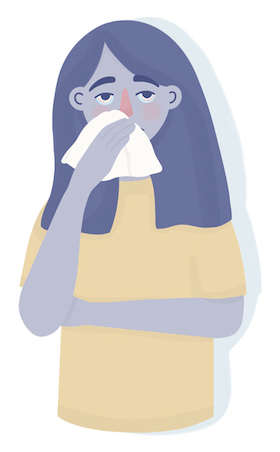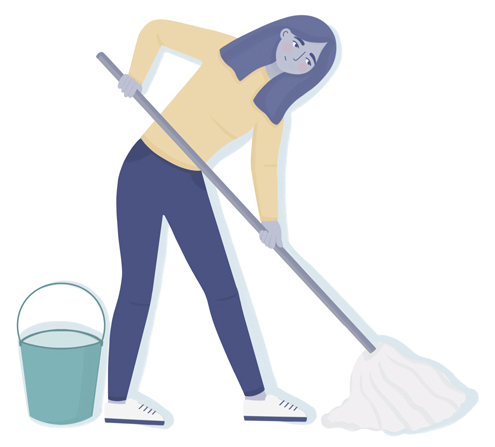 We all know what dust is. It rests on top of bookshelves, counters, and pretty much any surface. In truth, it’s pretty gross, and people have to clean regularly to make sure it doesn’t build up.
We all know what dust is. It rests on top of bookshelves, counters, and pretty much any surface. In truth, it’s pretty gross, and people have to clean regularly to make sure it doesn’t build up.
But where dust resides, dust mites can also be found. Dust mites are tiny organisms that consume airborne moisture and dust. Many people are sensitive to dust mites, and these allergic reactions may cause health issues throughout the year. A dust mite allergy may cause standard allergic rhinitis symptoms where a person’s nose runs or eyes start to water. Some people have a more extreme reaction to dust mites and may exhibit eczema or asthmatic symptoms.
People can help protect themselves from dust allergies by keeping their homes as dust-free as possible (by cleaning often) and by protecting their bedding with encasement mattress protectors and pillow protectors. However, that’s just the tip of the iceberg. Read on to find out everything you need to know about dust allergies
Dust Allergy Symptoms And Triggers
Okay, to start, how can people tell if they have a dust allergy? Well, let’s talk about how to spot the signs and discuss exactly what could be triggering a dust allergy.
Dust Allergy Symptoms
- Red, itchy, or watery eyes
- Sneezing
- Congestion or runny nose
- Coughing, wheezing, shortness of breath, or tightness in the chest
- Itching and rash
Dust Allergy Triggers
- Dust mites are the most common allergen associated with house dust. These mites live and flourish in environments that are warm and humid, especially when temperatures are 70 degrees Fahrenheit or more with humidity levels of 75% or more. If the humidity level is below 50%, dust mites will die. They do not live in dry climates. However, in more humid climates, particles from dust mites will collect in bedding, mattresses, upholstered furniture, and carpeting. When you vacuum or shake out bedding, dust mites become airborne then settle on surfaces. What’s scary is that even homes that appear clean can have dust mites. Typical cleaning procedures are often not effective for removing dust mites because they are so small.
- Cockroaches live in all types of environments. People who live in a house with cockroaches could develop allergies to the tiny particles the cockroaches release. These particles tend to mix with household dust.
- Mold is found everywhere, especially in moist areas of your home such as bathrooms and kitchens. Mold is an airborne fungus that can cause an allergic reaction. It can also mix with household dust! A person with a mold allergy will experience symptoms after inhaling mold spores. While some mold is easily visible, other types of mold are invisible.

- Trees, grasses, weeds, and flowers emit pollen into the atmosphere. Some people have allergies to specific types of pollen. Pollen may also mix with household dust.
- Pet hair, feathers, and fur may be the source of allergic reactions for some people. Pet dander, urine, and saliva are common allergens, and they may also mix with household dust, making allergic reactions worse.
Dust Mite Allergy Treatment And Management
Okay, so we know the signs of dust allergies and we know what causes them, but what are people supposed to do about it? First off, an allergy to house dust may require treatment from an allergist.
The allergist will ask questions about living and working environments, medical history, symptoms, and triggers to determine the cause of the symptoms. An allergist can also perform

skin tests to diagnose triggers. These tests involve pricking the skin with a sterile probe containing extracts from allergens such as dust, pollen, or pet dander. Someone with an allergy will have a reaction with a raised welt and redness.
After identifying a dust allergy, the allergist may suggest a prescription or over-the-counter medication. Many people find relief with decongestants or antihistamines. Corticosteroid sprays can reduce nasal inflammation. Allergy shots help increase tolerance to allergens. Oral immunotherapy is a treatment option that involves dissolving tablets under the tongue. An allergist will determine the best medication to treat symptoms and the correct dosage.
Whether a person sees an allergist or not, there are some basic and effective steps they can take to keep their home as dust-free as possible, while also protecting themselves from dust. Managing a dust allergy involves avoiding triggers that will cause a reaction. Follow these steps to reduce exposure to dust:
- Choose hard flooring instead of carpeting, especially in sleeping areas. If carpeting is already in the home, it might need to be removed.
- Clean regularly using a vacuum with a HEPA filter. Wear a dust mask while cleaning and for about two hours after cleaning to allow particles to settle. Also, read about how to clean mattress stains.
- Encase that comfortable mattress and pillow with a mite-proof case.
- Wash sheets and other linens often in hot water.
- Use a HEPA air cleaner in the bedroom.
- Keep pets out of the bedroom; their hair and dander can get trapped in the sheets and comforter.
- Keep the kitchen clean, covering all food and disposing of food waste in a sealed garbage can.
- Use roach traps or hire a professional pest service to control cockroaches.
- Install a high-efficiency filter on both the furnace and air conditioner. Use the fan on an HVAC system continually to filter the air and remove particulates. Change the filter every three months and HVAC units inspected and serviced twice a year.
- Measure humidity levels in the home with a hygrometer. Keep the humidity level below 55%, and use a dehumidifier if necessary. Remove moisture from bathrooms and kitchens with a vented fan. Repair water leaks promptly.
- If you cannot get your mattress clean, it might be time for a new mattress. Read our article on how often you should replace your mattress.
Overall
People don’t have to suffer from dust allergies. If you think you have a dust allergy, use the information listed above and make sure to see an allergist if your situation does not improve!
Resources
- Dust Mites: Dust mites like to eat the human skin scales that people shed on carpets, bedding, and furniture.
- House Dust Mites: Dust mites are related to spiders, chiggers, and ticks.
- Room-by-Room Checklist for Allergy Cleanup (PDF): Dusting frequently with a damp cloth will help remove dust mites from the home.
- Ten Tips to Tackle Winter Allergies: Mold spores can cause allergic reactions, especially during the winter months when homes are enclosed and moisture levels are high.
- Managing Dust Mites (PDF): Two different species of dust mites live in North America.
- Instruction Sheet: Allergies (PDF): An allergic reaction to a substance is caused because the body overreacts with symptoms such as sneezing, runny nose, and watery eyes.
- Cleaning to Control Allergies and Asthma (PDF): Set a cleaning schedule to reduce environmental triggers, washing bedding, wiping window sills, mopping floors, and dusting regularly.
- All About Allergies: The immune system considers an allergen to be a toxic invader, releasing chemicals designed to defend the body against the perceived threat.
- Dust Mites Can Cause Asthma: Asthma can be an allergic reaction to dust mites that exist in bedding, furniture, or carpets of a home.
- Dust Control Guidelines: Vacuuming and Door Mats (PDF): Using doormats at every entrance can be an effective way to minimize the amount of dirt that enters the home.
- House Dust Mite: Each female dust mite can lay up to 50 eggs that will hatch and become mature dust mites within three weeks.
- Asthma and Allergies (PDF): Pollen is usually the worst during the spring and the fall, making it important to keep the windows closed during these seasons.
- Allergic Rhinitis (PDF): Symptoms of allergic rhinitis include itchy eyes and throat, puffy eyes, runny nose, congestion, watery eyes, and sneezing.
- Allergies: What Causes Them, and What You Can Do: Allergies can impact up to 20% of the total population to some degree.
- Dust Mite Allergy: Dust mites live on every continent except Antarctica. They thrive in warm and humid environments.
FAQs
How do you treat dust allergies?
For people who are experiencing mild reactions to dust, treatment could be as simple as cleaning more often, vacuuming with a HEPA filter, removing carpeted area in the home and regularly changing your HVAC filters. For more extreme cases of dust allergies, a person might need to see an allergist, where they can conduct test to diagnose the triggers of the allergy.
What are some symptoms of dust allergies?
Some symptoms of dust allergies include:
- Red, itchy, or watery eyes
- Sneezing
- Congestion or runny nose
- Coughing, wheezing, shortness of breath, or tightness in the chest
- Itching and rash
Are dust mites real?
Yes, dust mites are very real. They are tiny organisms that consume dust and live in dark moist places. Many people are sensitive to dust mites as they can cause allergic reactions.
Featured Image: Suzanne Tucker/Shutterstock
